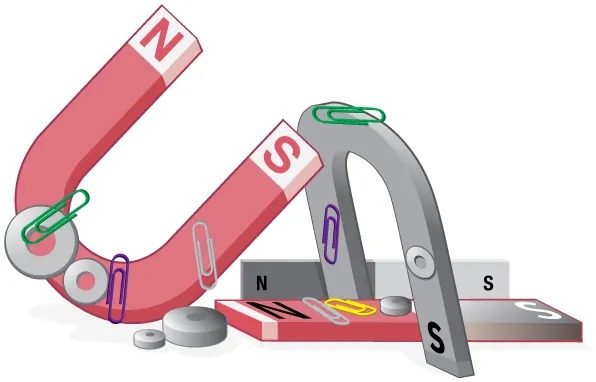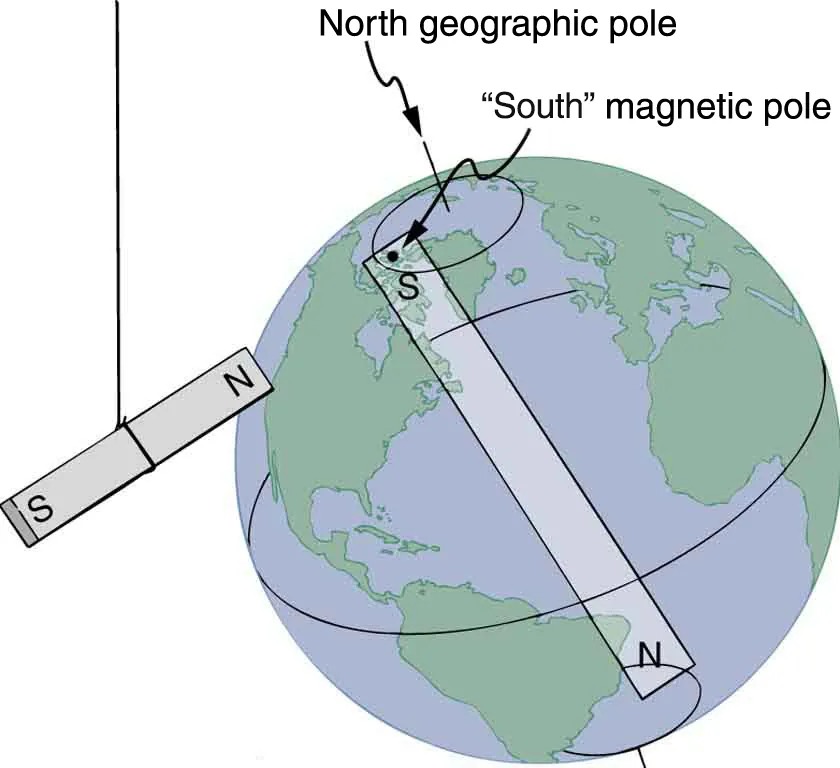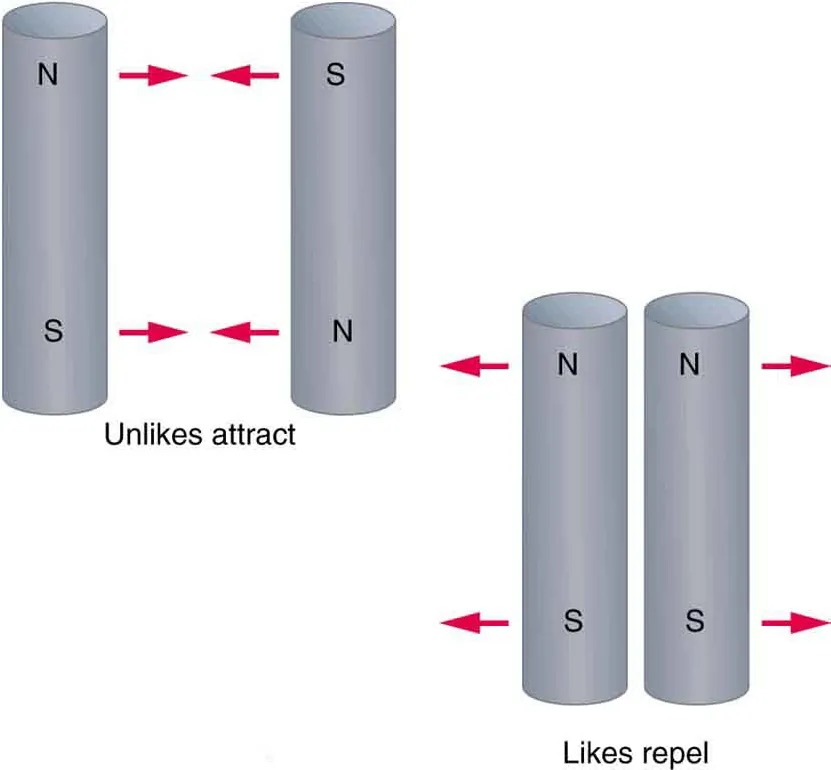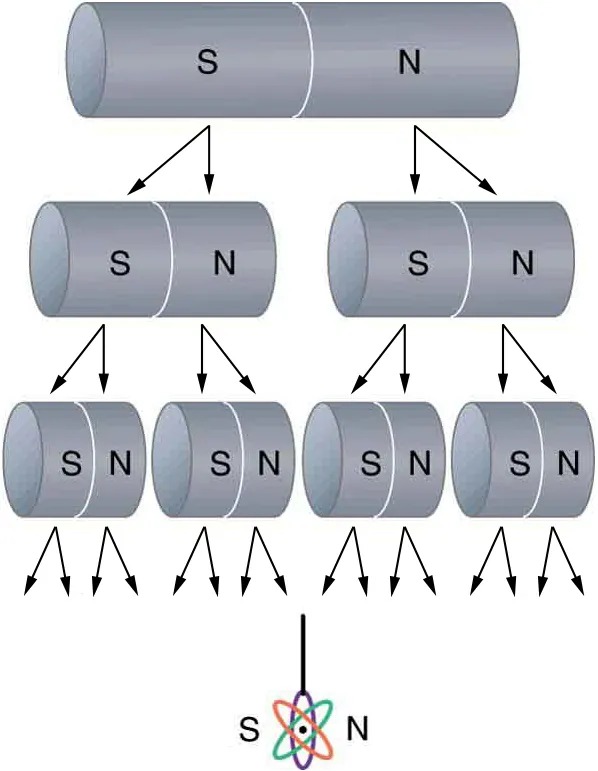17.1 Magnets
Learning Objectives
By the end of this section, you will be able to:
- Describe the difference between the north and south poles of a magnet.
- Describe how magnetic poles interact with each other.

Figure 17.3 Magnets come in various shapes, sizes, and strengths. All have both a north pole and a south pole. There is never an isolated pole Image from OpenStax College Physics 2e, CC-BY 4.0
Image Description
This image depicts three types of magnets with metal paperclips and small metal discs attracted to them. The magnets include:
- An U-shaped magnet on the left, colored red with the poles labeled ‘N’ for North and ‘S’ for South. Green and purple paperclips are attached to it, along with some small metal discs.
- A horseshoe magnet in the center, colored gray with the poles labeled ‘N’ and ‘S’. A purple paperclip is attached to it, along with a green paperclip on top.
- A rectangular bar magnet on the right, colored red and white with black letters ‘N’ for North and ‘S’ for South. An assortment of paperclips and small metal discs are attached to it.
All magnets attract iron, such as that in a refrigerator door. However, magnets may attract or repel other magnets. Experimentation shows that all magnets have two poles. If freely suspended, one pole will point toward the north. The two poles are thus named the north magnetic pole and the south magnetic pole (or more properly, north-seeking and south-seeking poles, for the attractions in those directions).
Universal Characteristics of Magnets and Magnetic Poles
It is a universal characteristic of all magnets that like poles repel and unlike poles attract. (Note the similarity with electrostatics: unlike charges attract and like charges repel.)
Further experimentation shows that it is impossible to separate north and south poles in the manner that + and − charges can be separated.

Image Description
The image is an illustration depicting the Earth’s magnetic field in relation to its geographic poles. The Earth is shown as a large sphere with continents visible.
- A vertical line represents the Earth’s rotational axis, connecting the North and South geographic poles.
- The North geographic pole is labeled, and nearby, the “South” magnetic pole is indicated.
- A rectangular bar magnet is shown outside the Earth with its ends marked “S” (South) and “N” (North).
- The magnet is positioned so that its South end is aligned with the North geographic pole and the Earth’s “South” magnetic pole, illustrating the concept of magnetic polarity.
- Curved lines surround the Earth, representing the magnetic field lines extending between the magnet’s poles.
Misconception Alert: Earth’s Magnetic Poles
Earth acts like a very large bar magnet with its south-seeking pole near the geographic North Pole. That is why the north pole of your compass is attracted toward the geographic north pole of Earth—because the magnetic pole that is near the geographic North Pole is actually a south magnetic pole! Confusion arises because the geographic term “North Pole” has come to be used (incorrectly) for the magnetic pole that is near the North Pole. Thus, “north magnetic pole” is actually a misnomer—it should be called the south magnetic pole.

Image Description
The image shows two sets of magnetic bars illustrating the concepts of attraction and repulsion between magnetic poles.
The set on the left consists of two vertical magnets facing each other with opposite poles. One magnet is labeled “N” (north) on top and “S” (south) on bottom, while the other is labeled “S” on top and “N” on bottom. Red arrows between the magnets point toward each other, indicating attraction. Below this set, the text reads “Unlikes attract.”
The set on the right shows two vertical magnets positioned parallel to each other with like poles facing each other. Both magnets are labeled with “N” on top and “S” on bottom, with red arrows pointing away from each other, indicating repulsion. Below this set, the text reads “Likes repel.”

Figure 17.6 North and south poles always occur in pairs. Attempts to separate them result in more pairs of poles. If we continue to split the magnet, we will eventually get down to an iron atom with a north pole and a south pole—these, too, cannot be separated. Image from OpenStax College Physics 2e, CC-BY 4.0
Image Description
The image shows a sequence depicting magnetic poles within cylindrical magnets and their division into smaller sections. At the top, there is a large cylindrical magnet with its left end labeled “S” (South) and the right end labeled “N” (North), separated by a line. This cylinder is connected with arrows pointing downward to two smaller cylinders, each similarly labeled with “S” and “N”.
From each of these smaller cylinders, additional arrows point downwards to even smaller cylinders, each labeled with “S” and “N”. The sequence continues, with each level of cylinders smaller than the last, suggesting a division into smaller magnetic sections while maintaining the “S” and “N” polar labeling.
At the bottom of the image, a single arrow points down to an illustration of an atom with an “S” and “N” labeled, which is surrounded by orbiting paths, representing electrons.
The fact that magnetic poles always occur in pairs of north and south is true from the very large scale—for example, sunspots always occur in pairs that are north and south magnetic poles—all the way down to the very small scale. Magnetic atoms have both a north pole and a south pole, as do many types of subatomic particles, such as electrons, protons, and neutrons.
Making Connections: Take-Home Experiment—Refrigerator Magnets
We know that like magnetic poles repel and unlike poles attract. See if you can show this for two refrigerator magnets. Will the magnets stick if you turn them over? Why do they stick to the door anyway? What can you say about the magnetic properties of the door next to the magnet? Do refrigerator magnets stick to metal or plastic spoons? Do they stick to all types of metal?

